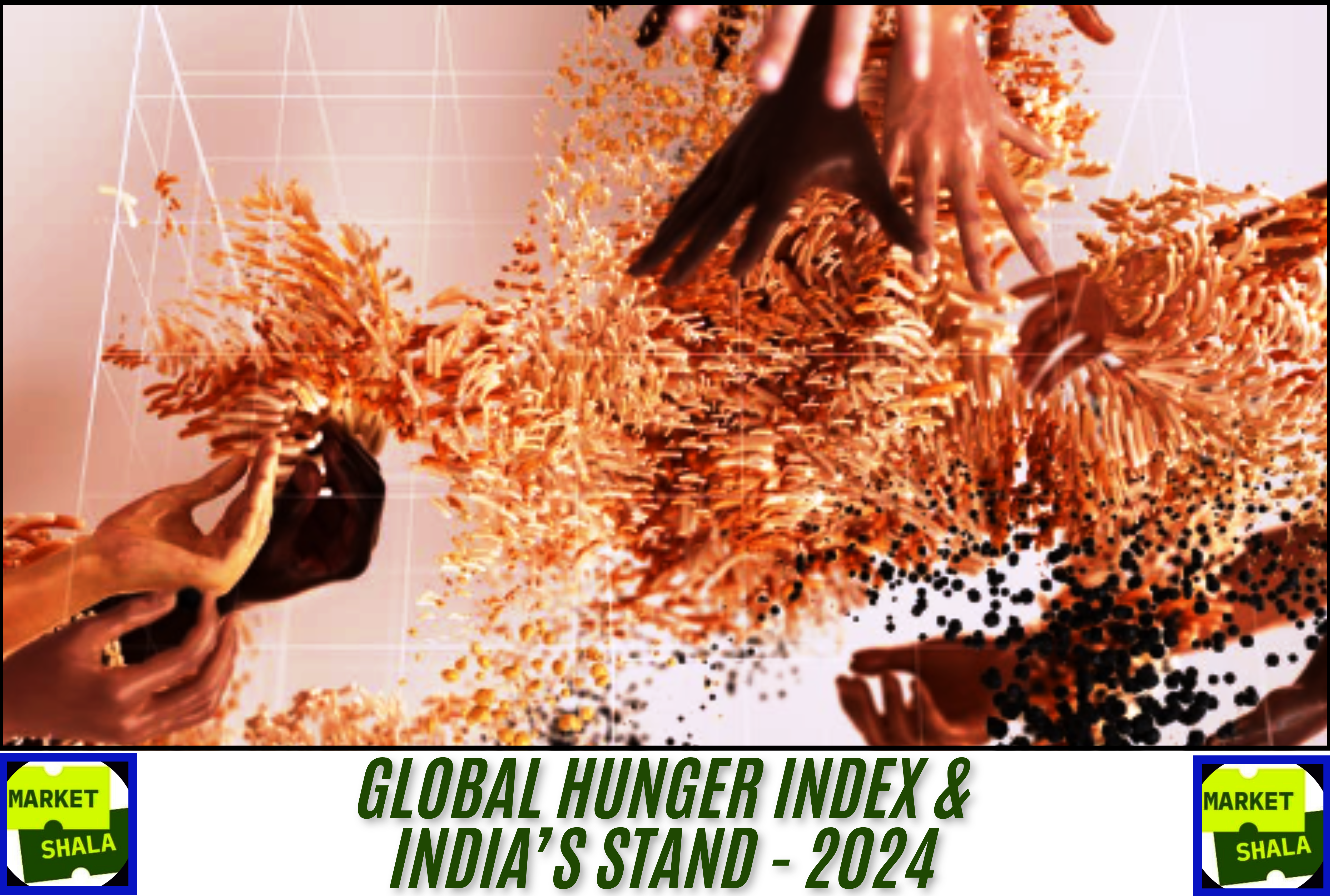The story of the Global Hunger Index: Is it really Flawed?
Hello MarketShalians, Today we will talk about the shortcomings of the Global Hunger Index (GLOBAL HUNGER INDEX) and discuss whether it is really showing the hunger standards of India in the right way.
You might know that every year Concern Worldwide and Welthungerhilfe, which are two big NGOs, bring out the GLOBAL HUNGER INDEX report. In this report, the hunger index of the countries of the world is rated out of 100 marks. According to this, the higher the score, the more serious is the hunger index of that country. Yes, this time India’s GLOBAL HUNGER INDEX has been rated at 27.3 which falls in the “serious hunger” category.
The Indian government is not at all happy seeing this score. For the last 2 years the Indian government has been raising questions on GLOBAL HUNGER INDEX and according to them the GLOBAL HUNGER INDEX report is not able to show the ground reality of India properly. So in this blog we also try to know whether the GLOBAL HUNGER INDEX report is really reliable or not!
Where is the problem in calculating GLOBAL HUNGER INDEX?
This index is measured using 4 indicators to generate a GLOBAL
HUNGER INDEX hunger score:
1. Undernourishment: How much of a country’s population is not able to meet its daily calorie needs.
2. Child stunting: Children who are less than 5 years of age and look smaller than their age indicate that such children suffer from chronic malnutrition.
3. Child Wasting: If the weight of children is less than their height, it shows that they are suffering from severe malnutrition.
4. Child Mortality: Death rate of children below 5 years of age.
The final score is derived from the data of the above points and it tells where the hunger level of a country stands. There is a problem in this and that is 3 out of 4 points are focused only on children. Undernourishment indicator is the only indicator which captures the hunger of the entire population.
What is the problem that Indian government is facing with the GLOBAL HUNGER INDEX, let us take a closer look at it.
1. When 75% of the surveys are based on children, how can the reality of the hunger index of the entire population of the country be measured from its report?
o Argument: It is not possible to accurately capture the hunger of the adult population and the entire population by focusing too much on stunting and wasting of children. In India, many food security programs are run by the government which are not limited to children only, but the people of the entire country benefit from such policies.
2. The GLOBAL HUNGER INDEX formula ignores cultural and physiological differences. The physical makeup of the Indian population is genetically smaller when compared with global standards. Hence, if GLOBAL HUNGER INDEX assesses Indian children on global height-weight benchmarks, they may be wrongly labeled as malnourished and the entire risk of making an incorrect assessment remains built into such a system.
3. Discrepancy in calorie requirement. The GLOBAL HUNGER INDEX requirement is 1,800 kcal/day and it measures undernourishment by considering it as a benchmark. But BMR (Basal Metabolic Rate) and physical activity levels are generally low in India. This is also one of the reasons that raises questions on the validity of this report as per Indian standards.
o A more realistic benchmark as per Indian standards could be 1,500 kcal/day. As this is not the case, the GLOBAL HUNGER INDEX score may overestimate the Indian hunger rate, which is quite likely.
4. Data collection is not standardized
o Be it household surveys or census, these activities are not timely in India. The last census was conducted in 2011 and 13 years have passed since then, then how can today’s hunger index be calculated on the basis of that old data. Without fresh data, it is not possible to get the correct picture from sample based surveys and such results will always remain a threat of not being authentic. This is also a reason why the government is not satisfied with the reports of GLOBAL HUNGER INDEX and keeps raising questions on it.
In this context, let us take a look at the progress of India.
The Indian government has taken some big and important steps
for this important task of food security and improvement of nutrition:
1. Pradhan Mantri Garib Kalyan Anna Yojana (PMGKAY)
o Under this scheme, free food grains are given to almost 80 crore people.
o During the time of Covid pandemic, more attention was given to food grain allocations and it was increased.
2. Poshan Tracker App
o This app was launched in 2021, through this app the nutrition of pregnant women, lactating mothers and children is monitored so that steps can be taken for its improvement.
o This app has also been promoted by UNICEF and WHO and almost 10 crore people in India are taking advantage of it.
With the advent of such programs, food access and nutrition have improved, despite all this some malnutrition indicators are still a cause of concern. For example, the rate of child wasting, which is 18% in 2024, is higher than 17% in 1999, which is a matter of concern.
Is it okay to focus GLOBAL HUNGER INDEX only on children-centric metrics?
GLOBAL HUNGER INDEX is linked to the United Nations Sustainable Development Goals (SDGs), which aim to eliminate hunger and malnutrition from the world by 2030.
• SDGs are focusing on the nutrition of young children because they believe that the period of childhood growth is very important for lifelong health.
• Adult hunger also needs to be measured as per the SDGs but the future of a country depends on how it nurtures its most vulnerable population and this can be known well only when the survey is based on child-centric metrics.
Does the GLOBAL HUNGER INDEX score make incorrect predictions?
While there are certainly shortcomings in the GLOBAL HUNGER INDEX methodology if we look at the facts, the facts and figures used to highlight important aspects of child malnutrition should not be ignored. The criticism by the Indian government is justified as the GLOBAL HUNGER INDEX score does not accurately reflect the hunger situation in the country or, in other words, its process is not designed accordingly. Here one thing the Indian government also needs to pay attention to is that if we want to give a strong response to global metrics then we also need to significantly improve our data collection and related surveys.
Final Thoughts: What is the solution?
The focus is on timely and accurate data collection to address the shortcomings of the Global Hunger Index.
• It is important that the Census is conducted in a timely manner so that sample-based surveys can be used properly and the accuracy of their results can be validated.
• India has a great opportunity to prove that there has been an improvement in domestic hunger and nutrition metrics and that we are not lagging behind world standards in any way. By doing this, India’s image will be created on the world stage and it will also be proved that India as a country is progressing very well.
This will ensure a confident and accurate narrative of India which will capture the real picture of India.
FAQ: Global Hunger Index and India
1. What is the purpose of Global Hunger Index (GHI)?
Global Hunger Index is a type of annual report which is released by Concern Worldwide and Welthungerhilfe NGOs. This report ranks countries worldwide on a scale of 0 to 100 on the basis of their hunger and malnutrition. It is believed that the higher the score, the more severe the
hunger of that country.
2. Why India is not convinced with its Global Hunger Index score?
The process defined for Global Hunger Index focuses on children hunger and nutrition value and gives scores based on that. Therefore, the actual data of adults and the efforts made by the government are not properly reflected in their scores.
3. Global Health Index score is based on which indicators?
• Undernourishment
• Child Stunting
• Child Wasting
• Child Mortality
4. What steps has India taken to reduce hunger?
• PMGKAY: Under this scheme, the government is providing free food grains to 80 crore people.
• Poshan Tracker App: This is a digital step through which the nutrition of children and pregnant women is monitored.
5. What is the main criticism of India on Global Hunger Index?
• GHI focuses more on children’s health indicators, which cannot measure real picture of hunger in the whole country.
• Global height-weight benchmarks do not match with India’s genetic profile.
• Old data and calorie benchmarks do not accurately measure hunger, which leads to overestimation.
6. What can be done next?
India will have to focus on its data collection process and collect it from time to time. New metrics also need to be developed so that the hunger situation can be dealt with properly.
Explore More on MarketShala
Stay updated with insights on global events, market analysis, and investment strategies on Markshala, where we aim to make financial education accessible and actionable.
Thank you for tuning in to Market-Shala’s Fintalk Dose — your essential source for insights into the financial markets, India and global economy. Now, let’s shift gears and unwind!
Treat yourself to the soothing tunes of MuziMuffin with his latest release available on Spotify, YouTube, Apple Music and Amazon Music. Relax, recharge, and enjoy the vibe!
***********
|| ॐ नमः शिवाय ||

